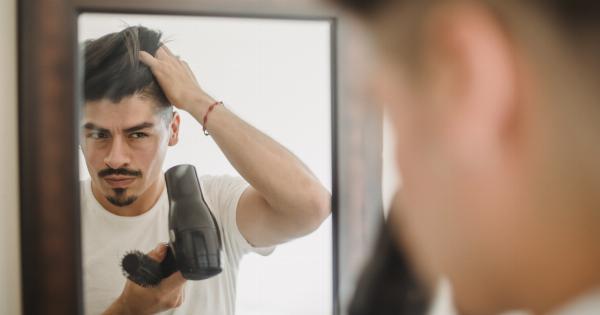Hair loss is a common condition that affects millions of people worldwide. It can be a distressing experience for both men and women, often leading to decreased self-esteem and confidence.
While hair loss is a natural part of the aging process, certain factors can accelerate the rate of hair loss or even cause premature balding. In this article, we will explore the various causes of hair loss and provide insight into how one can prevent or manage this condition.
1. Genetics and Family History
One of the most significant factors contributing to hair loss is genetics. If your parents or close relatives have experienced hair loss, it is more likely that you will also experience it at some point in your life.
This type of hair loss is known as androgenetic alopecia, or male/female pattern baldness. It is caused by the inheritance of genes that make hair follicles sensitive to a hormone called dihydrotestosterone (DHT), which leads to the shrinking of hair follicles and eventual hair loss.
2. Hormonal Changes
Hormonal changes can also play a role in hair loss, particularly in women. Pregnancy, childbirth, menopause, and thyroid disorders can all disrupt the delicate balance of hormones in the body and trigger excessive hair shedding.
The hormonal imbalance may cause hair follicles to enter a resting phase, known as telogen effluvium, where hair falls out more rapidly than it grows back.
3. Medical Conditions and Illnesses
Certain medical conditions and illnesses can lead to hair loss as a side effect. Autoimmune diseases like alopecia areata cause the body’s immune system to mistakenly attack the hair follicles, resulting in patchy or complete hair loss.
Scalp infections, such as ringworm, can also cause hair loss if left untreated. Additionally, conditions like diabetes, lupus, and nutritional deficiencies have been linked to hair loss.
4. Medications and Treatments
Some medications and treatments can have hair loss as a side effect. Chemotherapy drugs used in cancer treatment, for example, target rapidly dividing cells, including hair follicles.
This leads to hair loss during the treatment period, although hair often regrows once the treatment is complete. Other medications such as antidepressants, blood thinners, and hormonal contraceptives can also contribute to hair loss.
5. Inadequate Nutrition
A lack of proper nutrition can significantly impact the health of your hair. Insufficient intake of essential vitamins and minerals, such as iron, zinc, biotin, and vitamin D, can weaken the hair follicles, leading to hair loss.
Crash diets and restrictive eating patterns that deprive the body of necessary nutrients are often associated with hair thinning and loss. It is crucial to maintain a balanced diet to ensure your body receives all the necessary nutrients for healthy hair growth.
6. Emotional and Physical Stress
Stress, whether emotional or physical, can contribute to hair loss. During periods of intense stress, the body diverts its resources away from non-essential functions, such as hair growth, to prioritize vital organs.
This shift can lead to a condition known as telogen effluvium, where a large number of hair follicles enter the resting phase simultaneously, causing hair shedding.
7. Hairstyling Practices
Excessive hairstyling practices can damage the hair shaft and contribute to hair loss.
Hairstyles that tightly pull the hair, such as ponytails, braids, or buns, can cause hair breakage or traction alopecia, a condition where constant tension on the hair follicles leads to hair loss. Heat styling tools, such as straighteners and curling irons, can also weaken the hair, making it more prone to breakage and subsequent hair loss.
8. Smoking and Alcohol Consumption
Smoking and excessive alcohol consumption have been linked to hair loss. Smoking damages the blood vessels, reducing blood flow to the hair follicles and restricting the delivery of essential nutrients.
Similarly, excessive alcohol intake can negatively affect the absorption of vital nutrients, leading to hair thinning and loss over time.
9. Environmental Factors
Exposure to certain environmental factors can contribute to hair loss. Prolonged exposure to pollutants, chemicals, and ultraviolet (UV) radiation can damage the hair follicles and inhibit healthy hair growth.
Additionally, wearing hats or helmets for extended periods without proper ventilation can create a humid environment that promotes fungal infections and subsequent hair loss.
10. Age and Natural Hair Loss
Age is a significant factor in hair loss. As we grow older, our hair follicles become less active, resulting in thinner, weaker hair. This natural process is known as involutional alopecia.
While it is inevitable, proper hair care and a healthy lifestyle can help slow down the rate of age-related hair loss.
Conclusion
Hair loss can be attributed to various factors, ranging from genetics to lifestyle choices. Understanding the root cause of your hair loss is essential in developing an effective prevention or management plan.
Whether you have a genetic predisposition for hair loss or are experiencing hair shedding due to illness or nutritional deficiencies, it is crucial to consult with a healthcare professional or a dermatologist to explore the available options and find a tailored solution for your specific situation.
























